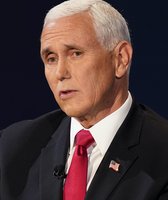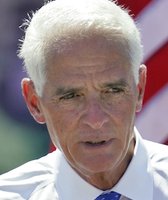Stand up for the facts!
Our only agenda is to publish the truth so you can be an informed participant in democracy.
We need your help.
I would like to contribute
Leave it to California to make attention-grabbing, movie-style political ads -- and then wacky sequels. Case in point: "Demon Sheep" and "Demon Sheep 2."
It started with an ad from Carly Fiorina, the former head of Hewlett-Packard seeking the Republican nomination for U.S. Senate. Her campaign launched a three-minute ad against former Republican Congressman Tom Campell. The ad attacked Campbell for his role in California's budget woes -- he was state finance director in 2005 -- and for his refusal to sign a no-new-taxes pledge. The name of the ad was "FCINO: Fiscal Conservative in Name Only."
But it became more widely known as "demon sheep." At its dramatic high point, it shows real sheep frolicking in a field while an obviously phony sheep with glowing red eyes prowls the perimeter, with ominous music playing in the background. (Our description doesn't even really do its weirdness justice, so watch it here.)
The Democrats decided to copy that ad with their own sequel, which they called "Demon Sheep II: The Fleecing of California."
"Carly has been very, very b-a-a-a-a-a-a-d," the narrator says, before making claims about Fiorina's tenure at Hewlett-Packard. (Watch it here.)
The ad says that that Fiorina was fired from Hewlett-Packard and received "a golden parachute worth $21 million," among other things. We wanted to check its claim about outsourcing jobs: "She sent 28,000 workers to the chopping block, 28,000 jobs, jobs moved heartlessly to China, India and Europe ..."
We wanted to fact-check how many workers Fiorina laid off: Was it 28,000? But when we finished our reporting, we couldn't agree among ourselves on a Truth-O-Meter rating because the evidence isn't clear-cut. We debated whether it should be rated Mostly True or Half True. So we present our findings here without a Truth-O-Meter rating.
A bit of history first: Fiorina was named CEO of Hewlett-Packard in July 1999, the first woman to lead a Fortune 100 company. She reorganized the company's structure and pushed for a controversial 2002 merger with Compaq Computer Corp., in an attempt to get a greater share of the personal computer market. The merger succeeded, but HP's board fired her anyway in February 2005 (with a $21 million severance package), primarily due to the company's sluggish stock price and missed earnings targets.
That doesn't sound so good, but Fiorina has her defenders. They point to the fact that today Hewlett-Packard now rivals Dell in the U.S. personal computer market and is routinely referred to as the world's largest computer maker. HP is competitive with IBM in selling servers and other computers to corporations, and it recently purchased Palm in a bid to compete with smartphone companies. Fiorina's supporters say none of this would have been possible without Fiorina shaking up HP's culture and urging the Compaq merger.
There's no doubt that Fiorina did lay off workers at HP as the company attempted to realign itself, and HP continued layoffs after she left. In fact, the Democratic Senatorial Campaign Committee pointed us to some of Fiorina's own remarks as their evidence for what the ad says.
"The facts are that I managed HP during the worst technology recession in 25 years," Fiorina told McClatchy Newspapers this year. "All technology stocks were way down. ... Yes, during the depths of the dot-com bust and a merger we laid off about 28,000 people. We also created more than 40,000 jobs. We doubled the size of the company, from $44 billion to $88 billion. We quintupled the cash flow. And we tripled the rate of innovation, as measured in patents per day. I'll run on that record all day long."
So Fiorina admits that workers were laid off, but said the overall workforce grew. To check these claims, we turned to the stock filings that Hewlett-Packard is required to file with the Securities Exchange Commission. Those filings showed a worldwide workforce of 84,400 in 1999, right after Fiorina became CEO. After the Compaq merger, the workforce hit 141,000 in 2002. That number grew every year for the rest of Fiorina's tenure. In 2005, just after her departure, it reached 150,000. (Last year, the number was 304,000.)
Some things to keep in mind: These are worldwide numbers, and the biggest gains came because of Hewlett-Packard's acquisition of other companies. Figuring out how many jobs Fiorina added to the U.S. workforce is difficult because the company does not routinely break out U.S. employees from its worldwide workforce. The Los Angeles Times looked in depth at Fiorina's hiring record in California and found the claims difficult to back up through proxy statements. The company said it had 74,000 U.S. workers in 2002; 60,000 in 2004; and 80,000 in 2006. That would potentially indicate a dip and then a rise during Fiorina's tenure, but again, it's difficult to say whether the job gains were the results of mergers or business growth. The numbers came from various news reports about HP, not from offical filings made on a regular basis. Fiorina wasn't shy about saying that some jobs ended up overseas. But domestically, it's difficult to tell if job gains outweighed layoffs, which made us hesitate to issue an official ruling.
Another thing to keep in mind: Fiorina's tenure at HP remains controversial, and people disagree about whether she moved the company forward. Two op-eds in the San Jose Mercury News earlier this year offered opposite takes. Craig Barrett, former chairman of Intel, defended her:
"Today, HP is a stronger company because of Carly Fiorina's bold action. Certainly some of this credit goes to current management, who capitalized on the changes Carly made. But it was Carly who shook up the status quo."
On the other hand, David Packard (the son of the company founder) opposed Fiorina's initiatives and wrote this:
"Fiorina's relentless pursuit of size and market share only served her personal ambition to be celebrated as 'the most powerful woman in American business.' Her fatal failing was her inability to win the respect of HP employees, which stemmed from her inability to trust, empower and motivate these employees."
Voters will make their own decisions about Fiorina soon; the California Republican primary is June 8.
Our Sources
Carly Fiorina campaign website, Video Release: Tom Campbell Exposed As A FCINO: Fiscal Conservative In Name Only, Feb. 3, 2010
McClatchy Newspapers, Fiorina says she's ready to represent California in Senate, March 28, 2010
The Los Angeles Times,Profits may not equal success; Carly Fiorina's business experience is a mixed blessing in political realm, May 20, 2010
The Wall Street Journal, Be creative, not protectionist, op-ed by Carly Fiorina, Feb. 13,2 004
The San Jose Mercury News, Analysts: Carly Fiorina long on vision, fell short on execution at HP, April 20, 2010
CNBC, Portfolio's Worst American CEO's of All Time, April 30, 2009
San Jose Mercury News, Opinion: Craig Barrett: History straightens out facts; Carly Fiorina positioned HP for success, April 4, 2010
San Jose Mercury News, Opinion: Neither of HP's founders would have endorsed Fiorina, April 22, 2010





















































